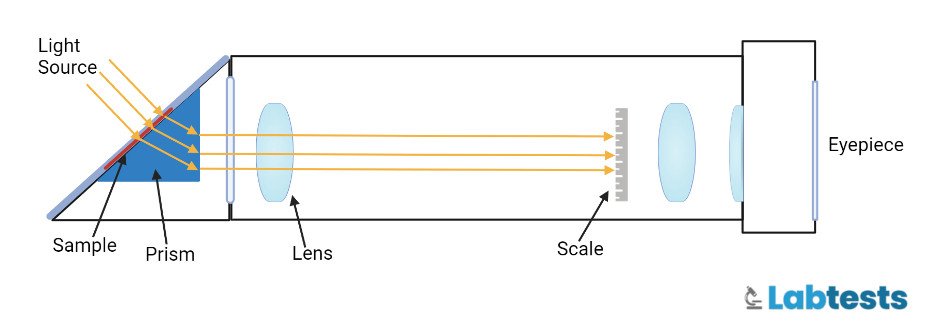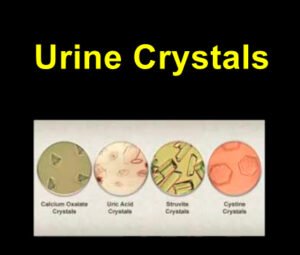The urine specific gravity test is a laboratory test that indicates the concentration of all chemical particles present in the urine. The urine specific gravity test is measured through urinalysis. Urinalysis is a non-invasive, painless way to assess renal functioning through a urine sample.
The urine is composed of normal and abnormal constituents. The normal urinary constituents are water which is about 95% of urine, electrolytes, creatinine, urea, and uric acid and the abnormal constituents are protein, glucose, blood cells, bile pigments, and bacterial microbes.
Specific gravity test for urine compares the urine density with water density. It is used to assess the functional status of kidneys, to indicate an underlying condition that is changing the fluid status of the body, to measure the total amount of dissolved material, and to look for the excretory and concentrating power of the kidneys
What is the Specific Gravity of Urine?
The specific gravity of urine also known as urine density is the ratio of the weight of a fixed solution volume with that of the same water volume, at 20℃, and in some books, it is 25℃.
Normal range of urine specific gravity test
The normal range for the random specimens is 1.003 to 1.035 and for 24 hr specimens is 1.015 to 1.030.
The specimen used for the urine specific gravity test
| Specimen Type Used | Urine |
|---|---|
| Container | Urine cup |
| Draw Volume | Entire urine collection |
| Processed Volume | Minimum volume 1 ml |
| Sample Rejection | 1. If a sample of urine is less than 1 ml. 2. It is mislabeled. 3. It is unlabeled. |
What are the prerequisites of the Specific Gravity Test?
The prerequisites of a specific gravity test are
- Specimen should be the first urine passed at the beginning of the day.
- Before that, a patient should avoid taking fluid for 10 hours.
- If we do urine specific gravity test on the random urine specimen, it will have low clinical value.
Collection of the Urine sample for Specific Gravity Test
Males
- First of all, clean the glans penis with soap and water.
- Then rinse the area by using wet gauze.
- If uncircumcised, holding the foreskin retracted, begin voiding.
- Discard the first several mL of urine, and collect midstream urine samples without stopping urine flow.
- Place and tighten the cap on the container.
- Refrigerate urine specimens after collection and promptly forward to the lab.
- Mention the type of specimen and also the time of collection on the label.
Females
- Properly clean the urethral area by using soap and water.
- Rinse this area with wet gauze pads.
- Hold labia apart, and begin voiding.
- Discard the first several mL of urine, and collect midstream urine samples without stopping urine flow.
- Place and tighten the cap on the cup.
- Refrigerate urine specimen after collection and promptly forward it to the lab.
- Mention the type of specimen and also the time of collection on the label.
Methods for the measurement of Specific Gravity
The following four methods are usually used to test the specific gravity of urine
- Urinometer
- Refractometer
- Reagent strip
1. The Urinometer

Parts
The Urinometer has three parts
- The stem that has calibrations i.e numbers marked on it to measure the specific gravity
- The float is the air containing part
- The weight is the lower end of the urinometer.
- The urinometer is a glass that is float weighed with mercury. It has an air bulb and a graduated stem.
- The urinometer is usually weighted to float at the graduations of 1.000 in the distilled water if we place it in a test tube of appropriate size or in a glass urinometer cylinder.
- The size of the test tube or cylinder is needed to be correct so let it float freely.
- We can directly observe the value of the specific gravity of the urine sample from a graduated scale in the stem of the urinometer.
- This scale is calibrated from 1.000-1.060 and has each division equal to 0.001.
Principle
The urinometer follows the principle of buoyancy. If there is an increased density of urine as compared to that of water, the Urinometer will float higher in urine than water.
Calibration Correction
It is very important to keep in mind that, to get the correct readings of the specific gravity of the urine sample, the urinometer should have readings of exactly 1.000. If the value is not exactly 1.000, we should apply correction to all the values that we get for specimens of urine with the urinometer.
Example
A urinometer reads 1.003 in distilled water. Water has a specific gravity of 1.000. Therefore, 0.003 is the correction of the urinometer that should be subtracted from the subsequent relative specific gravity. If the specific gravity is 0.037, minus this value with 0.003 and it will result in the corrected specific gravity of 1.034.
Temperature Correction
Temperature also affects the specific gravity of a solution. Mostly urine meters are being calibrated to be used at 15 °C. If there is a difference, add 0.001 for each 3℃. It must be subtracted if below, or added if above the calibration temperature.
Example
If the specific gravity of Urine is 1.022 at 23℃, and the urinometer is calibrated at 20℃. There is a difference of 3℃. The correct reading will be 1.022 + 0.001= 1.023.
Note: However, if the urine specimen is refrigerated then there will be a significant error. So, it’s important to warm up the urine specimen to room temperature before determining its specific gravity.
Abnormal Dissolved Substances Correction
If there is 1% glucose in the urine sample, the specific gravity increases by 0.004. Similarly, 0.003 increase in specific gravity is for every 1% presence of protein.
Therefore, 0.004 should be subtracted from the specific gravity for every 1% presence of glucose in urine sample. And 0.003 should be subtracted from the specific gravity for every 1% presence of protein in the urine sample.
Procedure for Using the Urinometer
- Fill the urinometer test tube or glass cylinder. It should be till 1 from the top. Almost 15 ml of urine is required.
- Remove all foam by using filter paper because this may cause difficulty in taking the readings of the meniscus.
- Insert the urinometer gently into the container.
- Float the urinometer inside the cylinder. It is needed to avoid touching the bottom or side of the cylinder.
- When it stops, note the graduation value present on urinometer stem. When you take a reading, the urinometer should not touch the sides of the container.
- Readings should be recorded.
- If the urine quantity is too small to float the urinometer, dilute it with distilled water.
- Read specific gravity and multiply the last two digits by the amount of the dilution.
- Note that the urinometer is calibrated at 20 degrees C. Temperature correction should be done to measure the correct specific gravity of urine.
Sample Calculation
- If the urine is diluted as 1:2 means there is one part of urine and two parts of water, multiply the last two digits of the urinometer reading by the dilution factor.
- If the reading of the specific gravity is 1.021, the last digit will be 0.021. And it is multiplied by the dilution factor that is 2 ( 0.021 x 2 = 0.042 ) and then added to 1.000 ( 1.000 + 0.042 = 1.042).
- Hence the corrected specific gravity of the sample is 1.042.
What are the Sources of Error?
Following are the sources of error that must be corrected.
- X-ray contrast media because it increases urine specific gravity
- Proteinuria
- Chemical preservatives
- Glycosuria
- Temperature differences
2. Refractometer
The refractometer is also an instrument to measure the specific gravity of urine, which notes the refractive index of the urine. The refractive index measurement depends that how many dissolved particles are present in the sample of urine.
The concentration of the dissolved particles is directly proportional to the refractive index.


3. Reagent Strip Test
Reagent strip test is also used to determine the specific gravity in urine. It depends on the ionic concentration of the urinary sample. Bromothymol blue is an indicator that detects a change. Colors range from blue through green to yellow-green.


Limitations of Urine Specific Gravity Test
The limitations of the urine specific gravity test are
- Diabetics with high glucose levels give higher values.
- Glucose or protein may increase the value of specific gravity out of proportion to osmolality when it is measured by a refractometer or hydrometer.
- In some settings, urine osmolality is preferred. Benitez et al suggested that urine osmolality is the only accurate measure of urine concentration in newborn infants.
- If radiographic dyes are present in the urine sample, it may increase the specific gravity by hydrometer or refractometer.
- Strip method urine specific gravity has a significant positive bias at urine pH ≤6 and negative bias at pH >7 compared to specific gravity by refractometer.
Frequently Asked Questions
Q1. What if the urine specific gravity test is below the normal range?
The urine specific gravity test below normal is called hyposthenuria. The specific gravity will be <1.007. The medical conditions causing hyposthenuria are Diabetes insipidus, Hypertension, Pyelonephritis, and all causes of polyuria except Diabetes Mellitus.
Q2. What if the urine specific gravity test is above the normal range?
The urine specific gravity test above normal is called hypersthenuria. The specific gravity will be > 1.030. The medical conditions causing hypersthenuria are Dehydration, Excessive sweating, Diabetes Mellitus (Glycosuria), Nephrotic syndrome, Albuminuria, and all causes of oliguria.
Q3. What if the urine specific gravity test is in the normal range?
The urine specific gravity test in the normal range is called isosthenuria. The normal range of specific gravity for infants (0 days – 1 year) is 1.002 – 1.006 and for >1 year age is 1.001 – 1.030. The medical conditions causing isosthenuria are Chronic Nephritis and an Arteriosclerotic kidney.
Q4. Which factors affect the composition of urine?
● Metabolic conditions of the body
● Diet and nutritional status
● Renal Functioning
● Contamination with pathogenic microorganisms like bacteria or even non-pathogenic microflora.
Reference
- Stuempfle KJ, Drury DG. Comparison of 3 Methods to Assess Urine Specific Gravity in Collegiate Wrestlers. J Athl Train. 2003 Dec;38(4):315-319. PMID: 14737213; PMCID: PMC314390.
- Flasar, Cathy APRN-BC, FNP, MSN. What is urine specific gravity?. Nursing Critical Care: November 2008 – Volume 3 – Issue 6 – p 9 doi: 10.1097/01.CCN.0000340988.20292.ba
- Gouyon, J.B., Houchan, N. Assessment of urine specific gravity by reagent strip test in newborn infants. Pediatr Nephrol 7, 77–78 (1993). https://doi.org/10.1007/BF00861579



